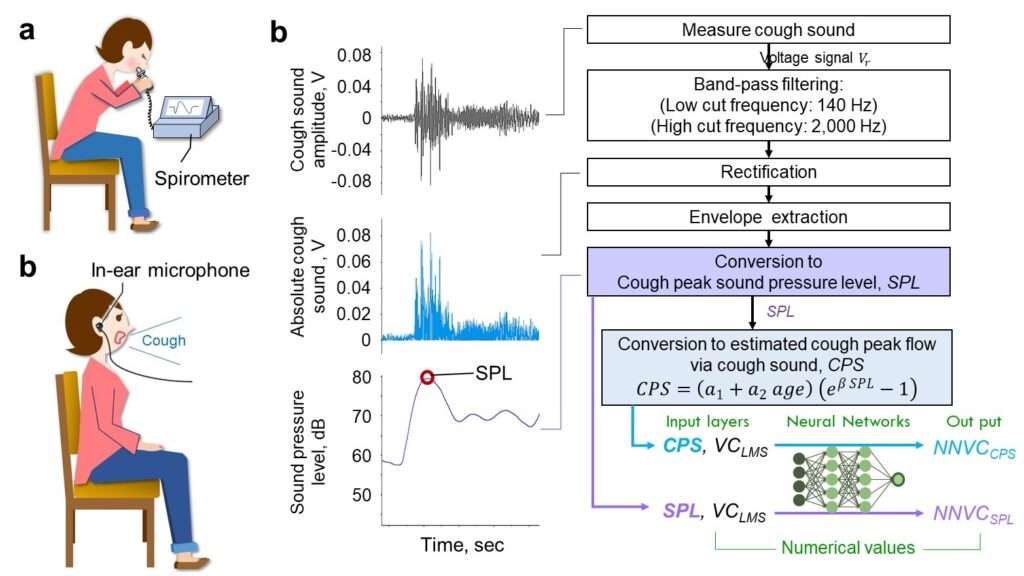広島大学生体システム論研究室では,博士課程修了生の馬屋原 康高先生(広島都市学園大学 健康科学部リハビリテーション学科 教授)を中心に,咳嗽音の評価と応用に関する研究に取り組んできました.
Estimation of Cough Peak Flow Using Cough Sounds
Yasutaka Umayahara, Zu Soh, Kiyokazu Sekikawa, Toshihiro Kawae, Akira Otsuka, and Toshio Tsuji
Sensors 2018, Vol. 18, No. 7, 2381 (1-13) Published online 22 July 2018; DOI: 10.3390/s18072381. (SCI, IF=2.475)
A Mobile Cough Strength Evaluation Device Using Cough Sounds
Yasutaka Umayahara, Zu Soh, Kiyokazu Sekikawa, Toshihiro Kawae, Akira Otsuka, and Toshio Tsuji
Sensors, Vol. 18, Issue. 11, 3810 (pp. 1-13), DOI:10.3390/s18113810, November 2018. (SCI, IF=2.475)
Clinical Significance of Cough Peak Flow and Its Non-contact Measurement via Cough Sounds: A Narrative Review
Yasutaka Umayahara, Zu Soh, Kiyokazu Sekikawa, Toshihiro Kawae, Akira Otsuka, and Toshio Tsuji
Applied Sciences, 10(8), 2782, doi.org/10.3390/app10082782, 17 April 2020. (SCI, IF=2.217)
Ability to Cough Can Be Evaluated through Cough Sounds: An Experimental Investigation of Effects of Microphone Type on Accuracy
Yasutaka Umayahara, Zu Soh, Tomoko Ozaki, Takafumi Murakami, Akira Otsuka, and Toshio Tsuji
Proceedings of the 2017 IEEE/SICE International Symposium on System Integration (SII), pp. 936-941, 2017.
咳嗽力評価の臨床的意義と今後の研究
馬屋原 康高, 関川 清一, 河江 敏広, 曽 智, 大塚 彰, 辻 敏夫
理学療法の臨床と研究, 第28号, pp.9-14, 2019.
咳嗽能力評価装置、咳嗽能力評価システム、咳嗽能力評価方法及びプログラム
日本国特許出願 2018-103992, 特開2019-005562, 特許第7134429号
馬屋原 康高,曽 智,大塚 彰,辻 敏夫
2018年5月30日出願, 2019年1月17日公開, 2022年9月2日登録
今回新たに,咳の音の大きさから肺活量を機械学習的に推定できることを見い出し,Scientific Reports誌に論文が掲載されました.
Cough sound-based estimation of vital capacity via cough peak flow using artificial neural network analysis
Yasutaka Umayahara, Zu Soh, Akira Furui, Kiyokazu Sekikawa, Tsuyoshi Imura, Akira Otsuka and Toshio Tsuji
Scientific Reports, volume 12, Article number: 17649, doi:10.1038/s41598-023-35544-3, Published online: 25 May 2023. (SCI, IF=4.996)
URL: https://www.nature.com/articles/s41598-023-35544-3
PDF: https://www.nature.com/articles/s41598-023-35544-3.pdf
今後も馬屋原先生とともに本技術の社会実装を進め,臨床での研究成果につなげていければと思っています.ひきつづきよろしくお願いします.
<論文内容>
This study presents a novel approach for estimating vital capacity using cough sounds and proposes a neural network-based model that utilizes the reference vital capacity computed using the conventional lambda-mu-sigma method and the cough peak flow computed based on the cough sound pressure level as inputs. A total of 56 samples of cough sounds and vital capacities were collected from 31 young and 25 elderly participants. Model performance was evaluated using squared errors, and statistical tests including the Friedman and Holm tests were conducted to compare the squared errors of the different models. The proposed model achieved a significantly smaller squared error (p<0.001) than the other models. Subsequently, the proposed model and the cough sound-based estimation model were used to detect whether a participant’s vital capacity was lower than the typical lower limit. The proposed model demonstrated a significantly higher area under the receiver operating characteristic curve (0.831, p<0.001) than the other models. These results highlight the effectiveness of the proposed model for screening decreased vital capacity.
本研究では,咳嗽音を用いて肺活量を推定する新しいアプローチを提示し,従来のlambda-mu-sigma法を用いて計算した肺活量と咳音圧レベルを基に計算した咳嗽時最大呼気流速を入力とする機械学習モデルを提案した.若年群31名と高齢群25名から合計56サンプルの咳嗽音と肺活量を収集した.モデルの性能は自乗誤差で評価し,Friedman検定やHolm検定などの統計検定を行い,異なるモデルの自乗誤差を比較した.提案モデルは他のモデルよりも有意に小さな自乗誤差(p<0.001)を達成した.さらに提案モデルを用いて,参加者の肺活量が標準下限値より低いかどうかを検出した.提案モデルでは,他のモデルに比べてROC曲線から求めたAUC値が有意に高い(0.831, p<0.001)ことが示された.これらの結果は,肺活量の低下をスクリーニングする提案モデルの有効性を示している.



